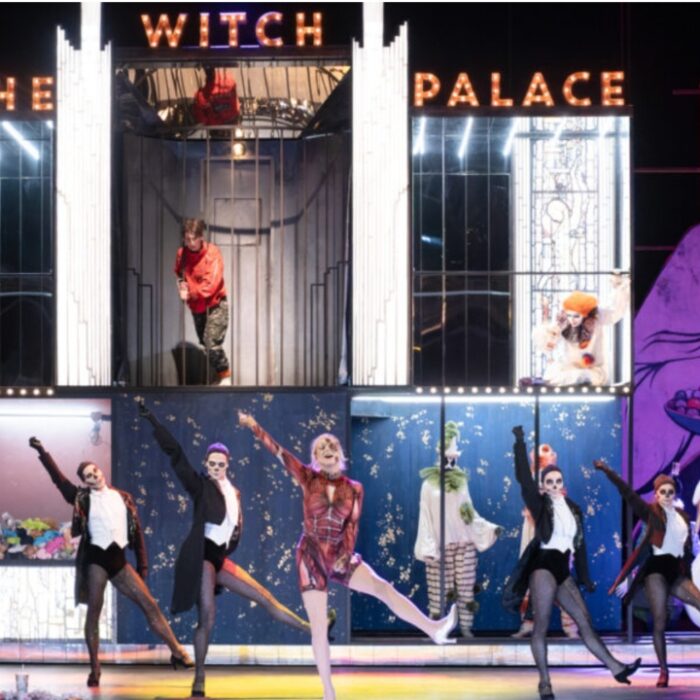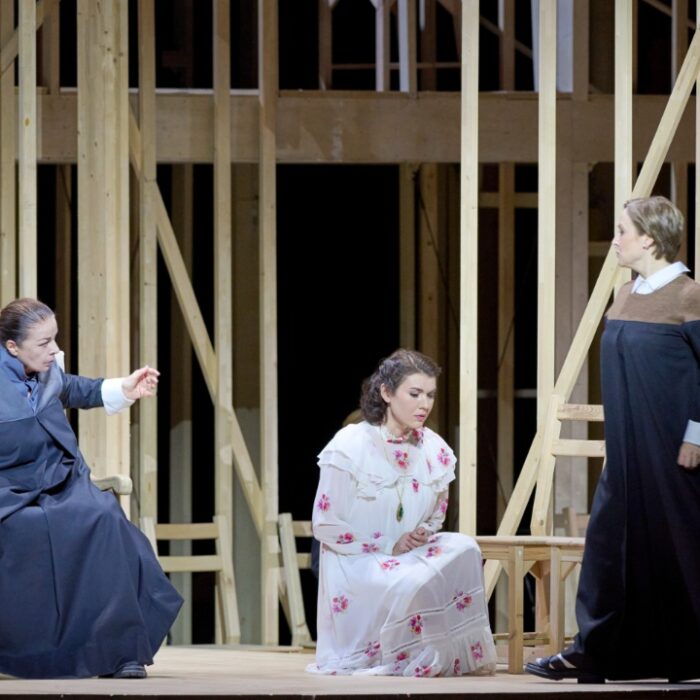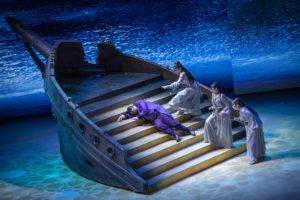
Royal Opera House Muscat 2019-20 Review: Die Zauberflöte
Davide Livermore’s Interpretation Aims to Bridge Two Worlds, But Doesn’t Manage Tonal Balance
By David Salazar(This review will focus on the Jan. 4 performance, though with mentions of the Jan. 3 performance as well.)
There is a moment near the end of Davide Livermore’s “Die Zauberflöte” at Muscat’s Royal Opera House of Musical Arts in which Tamino and Pamino must face the trials by fire and water with the magic flute in tow. But Livermore opts for a very different trial – the two lovers must come to terms with the death of their older selves in order to fully appreciate the love they have for each other.
As staged, this moment features doubles of each character in older makeup to express these more mature forms. Both Tamino and Pamina of the present recognize these forms as each other but fail to notice the difference in age until they watch these beloved selves dying on the ground.
It is a symbolic moment that opens up a great deal of questions about intention, especially given the context of the production’s origination in Oman. Is the final trial the realization for these characters that they are bound to one another until death do them part? Or is something else afoot? There’s no denying that the part engages intellectually and even emotionally, as the characters ultimately overcome the sadness of losing each other to find one another at the end, ready to live happily ever after.
During the Saturday night performance of the three-showcase run that started Thursday, one audience member celebrated the victory with a raised arm of a fervent aficionado.
And yet the moment felt rather strangely out of place in this production, which while thematically engaged and well-intentioned, fumbles much of the tonal execution, placing it at odds with itself in the larger cohesive picture.
West & East
On a purely story level this rendition is a fun romp that changes little to Mozart’s iconic opera from a plot level. Every major beat plays out as intended with some revisions to text made to suit the Omani public. In this manner, the opera is suitable for all ages and the essential story of good trumping evil and light vanquishing darkness remains clear and vibrant.
As framed, Livermore’s endgame seems about bridging two different perspectives and audiences. He is thus telling the story of Western culture and Omani culture coming into contact with one another and how that interaction leads to love and unity. One of the major themes of Omani culture is its emphasis on brotherhood with the country’s population made up of citizens from diverse continents. In speaking with a few people at the Grand Mosque of Qaboos during an earlier tour of the city, it was evident to me that there is also an internal cultural desire to bring to together Muslims of differing branches under the same roof. As such, the production itself, which was inspired by the Royal Opera House Muscat’s General Director Umberto Fanni and his own experience with the culture throughout his tenure, seems to form under this general vein.
Tamino appears in purple European dress, the only character to do so, thus establishing him as a foreigner in this country. The remaining characters, especially Sarastro, the three boys, and his men are in traditional Omani dress with Pamina’s wardrobe an elaborate pink outfit that comes off as exotic more than necessarily culturally specific. The Queen of the Night and her Three Ladies are a bit more abstract in design while Papageno’s look is Eastern, though far less defined than that of Sarastro and his men.
Symbols of Omani culture, such as its fishing tradition, the famed Omani dagger and the symbol of the sun are present throughout, though the level of nuance is hard to say. However there is no doubt that some touches are also clearly aimed at many of the tourists from Western countries as well and that perhaps the overall narrative gears toward that audience’s mindset more prevalently (Livermore is Italian afterall).
At one point, Tamino enters the stage and finds a magic lamp in the middle of the desert. For those wondering, yes it resembles the iconic lamp from “Aladdin,” a story which despite being a popular touchstone of the “Arabian Nights,” is often credited to French Antoine Galland and his translation of the famed text in 1704. Tamino looks at the lamp incredulously and notes that he doesn’t believe in fairy tales. But nonetheless, he gets down on one knee and rubs the lamp’s side. Out come the three boys as if magic genies that gift the hero with his flute and later save lives left and right.
The opera’s staging plays up other symbolic gestures with Tamino arriving by ship that defines the narrative as focused on foreign audiences. All of the major characters interact with the shipwrecked vessel at some point as a denotation of their power or stance. Pamina arrives at it near the end when she chooses life over death, while the Queen’s first entrance is aboard that ship. Sarastro takes it over at one prominent moment in the second act, while Tamino eventually returns to it only at the very end of the work when he has found love and triumphed over darkness.
In this context, the Queen telling Tamino that Sarastro is vile and wicked might be read in the current political climate as the Western world seeing the Arabic world with that negative connotation. But upon actually immersing themselves in the culture, as Tamino does with Sarastro, one comes to the understanding that there is goodness to find; thus Tamino’s enlightenment is more about newfound cultural awareness as a form of higher consciousness. There is no pretense at the close of the opera that Tamino will take up Muslim culture, though his walking away with Pamina on his ship and joined by the Papagenos suggests that he might be bringing a part of the culture away with him on his return voyage. The production thus suggests that Tamino is like many tourists and ex-patriots in audience, learning about the culture and walking away with a unique perspective.
Some might find it questionable that despite the happy ending, the people joining Tamino on his voyage are in some ways the most exotic, propogating a cultural barrier. However, a more cynical interpretation might also view these choices as a subtle critique to western cultural views that Tamino takes these characters with him specifically, potentially subverting the idea that he has in fact learned anything. At the very least, the production, in its openness about cultural encounters and misunderstandings, seems to be asking for this level of cultural discourse on a thematic level.
But where the production struggles is in its ability to manage the ebbs and flows of its tone, a challenge for any director taking on this shapeshifting opera.
Livermore is at his best when engaged with Papageno and his interactions, which are lively and aptly handled, always connecting to character. But the comedy also pushes into the realm of the cartoony in many instances. One such instance would be the handling the three ladies. Livermore seemed to struggle with the competing personalities of the three ladies, opting for an overly loud approach that seems to be screaming for audience approval instead of being integrated into the full texture of the overall storytelling. Compared to how he handles Papageno, Livermore’s work with the three ladies is, in a word, inelegant and always feels completely out of place.
In an opera where all facets of humanity are present, comedy definitely has a place in the larger structure. But it needs to play in balance with the more serious nature; there needs to be a tonal consistency across both extremes to allow greater sense of unity for the audience. Such degrees within each tone create the feeling of sloppiness and improvisation in scenes, almost as if some of them sought the easiest way to get a laugh instead of earning it. This is what happens with the three ladies and their constant attempts to one-up each other (there are diminishing returns on their antics after a few scenes) as well as other instances that will be relayed with specific characters.
From those exaggerations he moves to a sterile feel in the more serious moments of the opera with static stagings where characters stand and sing, doing little else. That is why, when late in the opera, he pulls out the symbolic “dance of the doubles,” the moment, while unique, also feels rather out of place in the larger picture. It comes from nowhere aesthetically, not setup within the context of the other stage gestures.
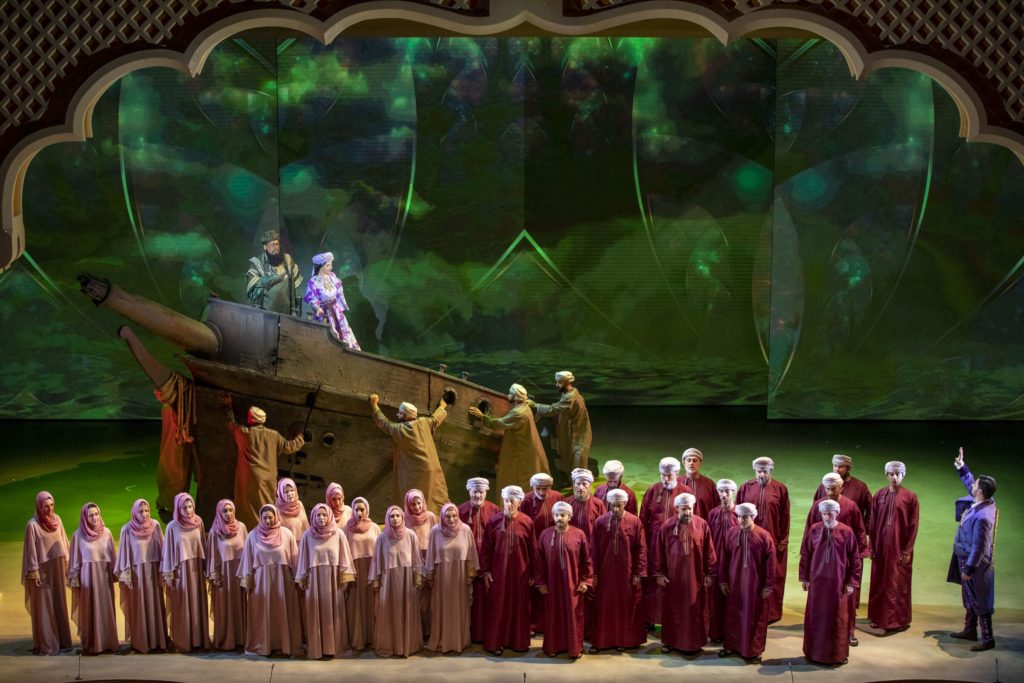
(Credit: Khalid Albusaidi, ROHM)
Sloppy Ensembles
The tonal and structural imbalance was perhaps most ever-present in the pit where conductor Diego Fasolis and his famed and prestigious “I Barocchisti” were surprisingly disappointing across two evenings (the Jan. 3 and 4 performances).
The Jan. 3 performance was the better of the two from an orchestral standpoint with the instruments generally in better shape and the music making far cleaner and clearer. But the Jan. 4 performances featured a wide range of sloppiness, particularly in the wind sections where faster passages and runs were far from polished; this was very apparent during the overture and particularly in its second half. The opera’s titular magic flute, played by Stefano Bet, sounded anything but the descriptor; Bet’s first solo passage during Pamino’s aria “Wie stark ist nicht dein Zauberton,” was lacking in fluidness, many notes garbled. One might wonder whether this was the result of three straight nights of performances and whether fatigue might be having an impact.
But in other arias, the orchestra faltered. Violin solos in Papageno’s first aria felt a bit off in pitch and there were several instances where the strings didn’t quite coalesce together, especially in the higher reaches of their ranges; this was notable in Sarastro’s second aria “In diesen heil’gen Hallen” on both nights.
But while the playing was not great throughout, the deeper issue seemed to be with the maestro himself who seemed rather distanced from his soloists onstage. There were several instances across the two evenings where it was clear that he was not listening to the singers, but expecting them to be on his time at all cost. During the Jan. 3 performance, bass Luiz-Ottavio Faria struggled through “In diesen heil’gen Hallen” as the orchestra rushed ahead of him on two separate occasions. As staged, he was supposed to be looking to Pamina throughout, but wound up obviously putting all his attention toward the maestro. On Jan. 4, Stefan Kocán spent most of that aria looking at the maestro instead of interacting with his colleague. It led to a better musical end product, but lacked the dramatic immersion it might have had Kocán focused on his stage partner.
On Jan. 4, Markus Werba struggled to pull out the two sticks for the glockenspiel during a latter repetition of the main theme of his aria “Ein Mädchen oder Weibchen.” Throughout the aria, Papageno uses the sticks to play the magical glockenspiel in perfect coordination with the orchestra’s Celesta player. For the audience, it was already visually established. So when Werba struggled with the physical cue and still had to sing alongside the glockenspiel, the spell was momentarily broken and the emphasis placed on the wrong thing. Fasolis did not need to launch ahead and could have actually stopped to wait for his soloist, even if it would have stopped the momentum of the music (there was a rest in the score), allowing for a light moment in the drama. But as noted, he was not attuned to his soloists throughout and simply barged ahead, to the detriment of the dramatic moment. That Werba managed it well is all the credit to the artist.
To his credit, Fasolis was ready to adjust his tempo during the coloratura runs of the Queen’s “O zittre nicht.”
Most arias didn’t suffer from these issues, but Fasolis’ questionable performances arose mainly in ensembles where issues seem to be commonplace. On both nights, the trio between Tamino, Sarastro, and Pamina lacked in any sense of coordination or togetherness. On the latter night, one saw the singers looking for help from the maestro throughout, but it did not seem to do anything as the issues persisted throughout the ensemble.
Seemingly taking cues from the stage direction’s approach, Fasolis allowed for his three ladies (sung by Vanessa Goikoetxea, Lara Rotili, and Teresa Iervolino) to compete vocally with one another, never seeming so much a team as a bunch of soloists trying to outdo one another. It created a massive imbalance vocally that did little to favor any of the artists either. The same imbalance happened with the trio of boys, sung by David Lech, Magnus Fischer, and Karl Huppert, with one voice clearly favored over others. In the case of both trios, intonation issues ran rampant and one was left to wonder whether any of the soloists were listening to one another. In the case of the three ladies, it is also perhaps the questionable musical execution that made the staging all the more problematic.
Ditto to the scene between the two armored men sung by tenor Saverio Pugliese and baritone Omar Kamata. On both nights, but particularly on the latter, Pugliese barreled over his colleague, the baritone barely audible as the tenor sang fortissimo the entire time. One might wonder whether this was a difference in vocal sizes, but in a latter scene with Tamino, Pugliese pulled back and blended quite well with his colleagues.
When this kind of ensemble imbalance is symptomatic of every single moment featuring more than one soloist, there is no doubt that responsibility falls on the conductor. One must imagine that this, and the ensemble’s lack of depuration, must have been the result of limited rehearsal. But it is the kind of mishaps one expects of an opening or even second performance when details are being ironed out. When it is the end result (at least in the context of this run), then one might surmise that the person in charge intended it.
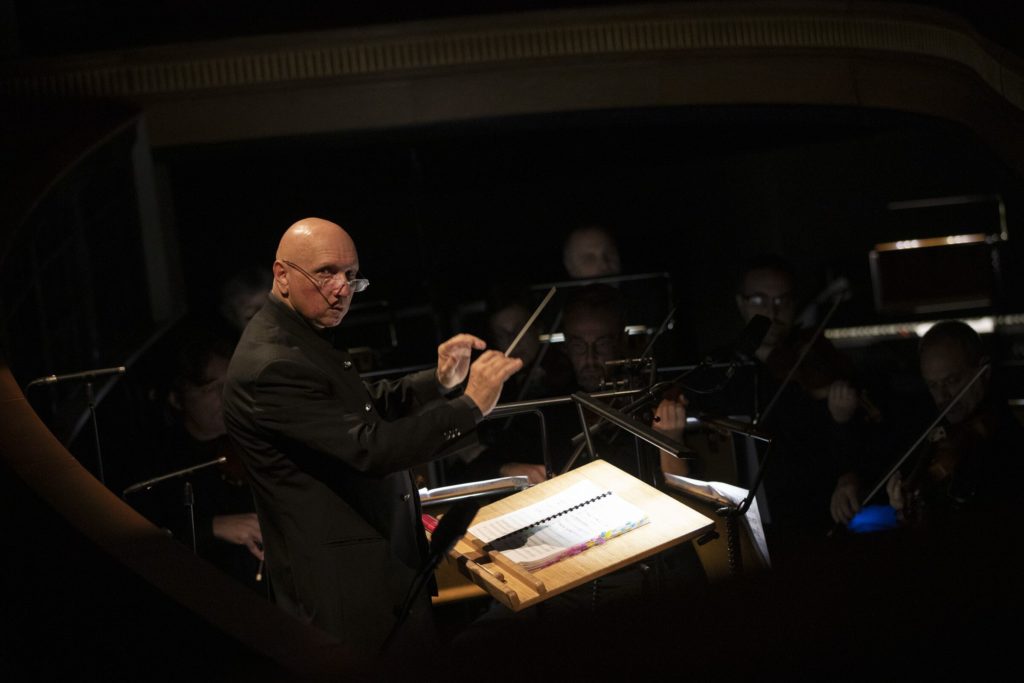
(Credit: Khalid Albusaidi, ROHM)
The Birdlover At the Core of It All
There is no doubt that this production was all about Markus Werba’s Papageno and he dominated every moment he was onstage. His charisma was irresistible; a comparison to Johnny Depp’s Jack Sparrow in the first “Pirates of the Caribbean” and its function in that film alongside the more serious character is probably right in line with this interpretation. He came onstage from the audience on two occasions, breaking the fourth wall to play his pipe and the glockenspiel in both of his arias; this kind of fun was catered toward audience interaction, but also plays to the opera’s larger idea that the character is the lone representative of the common folk’s plight. While the opera centers on a legendary prince’s journey toward enlightenment, Papageno’s arc is about more human desires like overcoming loneliness and finding connection and love.
Werba sang all three nights and was quite potent across the final two shows, with the voice showing few signs of fatigue across any performance. There was an effervescence in his delivery that coupled with his non-stop physical engagement lit up every single scene he appeared in. Nowhere was this more present than in his interactions with Papagena throughout the second act where her every word drew a combination of derision but identification with her. When he did proclaim that he would rather an older wife than death, you felt that the interactions between two gave this statement veracity. The final duet with mezzo-soprano Lucia Cirillo’s Papagena was the crowning moment of the drama, with the two spot on vocally with one another as they engaged in a pillow fight over whether to have Papagenos or Papagena’s. Cirillo was a comedic gem throughout, particularly as she imbued the old lady with a nasal and overzealous quality that played perfectly with Werba’s overenthusiastic Papageno.
It must be said, however, that one felt a bit of the characterization truncated and this was undeniably the result of stage direction that had to conform to cultural regulations.
The darkness of the character was essentially eliminated with Papageno’s own tragic “Sterben macht der Lieb’ ein End” rewritten to avoid any suggestion of suicide. It dehumanized him slightly, making him more comic relief than fully fleshed human. It was interesting to note that Pamina’s own suicidal “Sterben will ich – weil der Mann“ was not only present but staged with the character holding a dagger and readying to deliver the death blow.
However, ultimately, the Papageno comedy never seemed to be overzealous or trying too hard for its audience’s approval. More than bringing attention to his antics, Werba’s was the result of interactions with other characters, even if some happened to be audience members (one member didn’t seem interested in collaborating during the Jan. 4 show during the second aria, but Werba toyed with him until eventually winning him over; this added to the dramatic situation instead of hindering it).
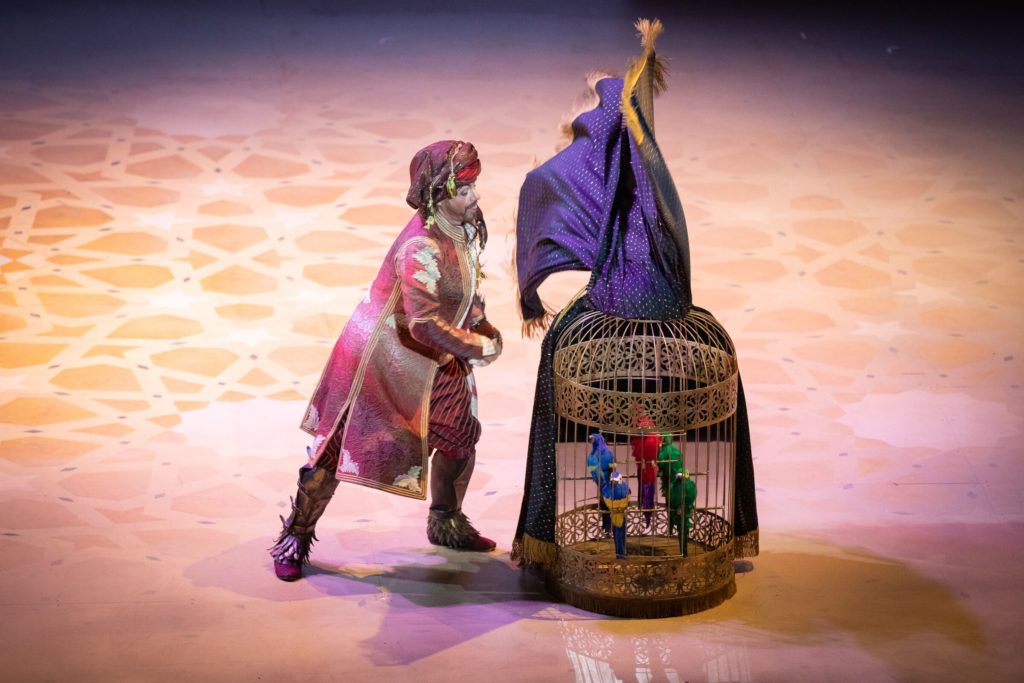
(Credit: Khalid Albusaidi, ROHM)
Prince & Princess
At the heart of the story was this interaction between two worlds, personified by Tamino and Pamina. Nothing in their individual portrayals outside of their wardrobe expressed this cultural divide, and on the Jan. 3 performance, the relationship didn’t really develop beyond the text’s own definition of their love. Nonetheless it must be stated that tenor Antonio Poli and soprano Giulia Semenzato both sang well, the former featuring a powerful tenor and the latter a delicate soprano.
But the performances from soprano Enkeleda Kamani as Pamina and tenor Alasdair Kent brought the personalities of the two to life. Kent’s Tamino was a charismatic prince, flirtatious with Pamina in their initial interaction and playing off of Werba’s antics quite well; the two looked like brothers constantly engaged in a quarrel with Kent showing increasing agitation as he tried to get Werba to just shut up.
Kent’s singing had nuance and refinement, the infamous interval leap from B flat to G natural in the passaggio at the start of “Dies Bildnis ist bezaubernd schön” managed with suavity. In general, the singing, while very light (his voice resonated well enough in the Royal Opera House of Musical Arts), was shaped quite beautifully with the tenor building his climaxes intelligently. There were several instances, particularly later in the evening, where high notes on closed vowels lacked the tonal clarity of high notes on open ones; at the beginning of the night, particularly with “Dies Bildnis,” he managed the several high As on “Ewig” and “Busen” without any such difficulty.
As Pamina, Kamani sang beautifully throughout, her sound resplendent in the hall and her tone even throughout. She was at her finest during the duet with Papageno where she was finely attuned to every vocal gesture with Werba and her character displayed spunk that made her instantly loveable. But her aria “Ach, ich fühl” was arguably the vocal highlight of the night from any singer. She sang the aria with increased agitation in the early going, the first G natural on “es ist verschwunden” a cry of pain and the subsequent high B flat on “der Liebe glück” building off it to more intense effect. And if that wasn’t already full of great tragic feeling, the sixteenth and thirty-second note runs on “Meinem Herzen” built up the sense of betrayal all the more with Kamani’s voice truly blossoming to the high B flats.
From there, she took the aria with increasingly softened tone, the final phrases softer and softer as if Pamina, after expressing all the pent-up frustration and pain at the opening, was fading away, an emptiness taking over her. The last lines of the aria were the most sublimely pained piannissimi one could want for this aria.
This made her ensuing scene with the three boys all the more credible dramatically, the soprano imbuing Pamina with a sense of desperation during “Sterben will ich – weil der Mann,” that eventually transformed into a brighter and refined vocalism that resembled her initial entrances.
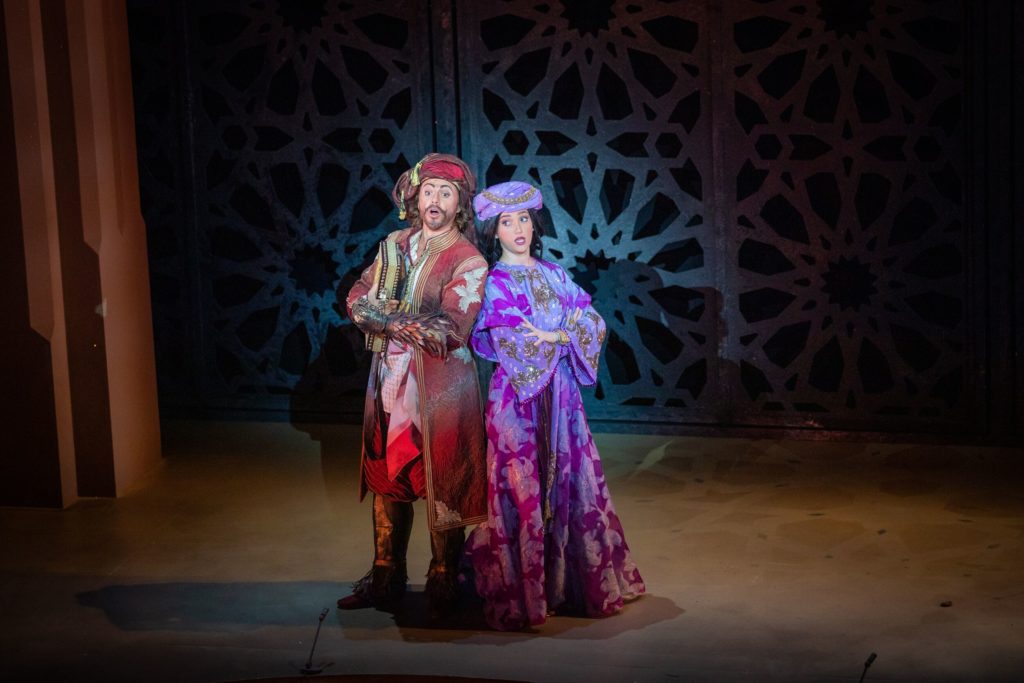
(Credit: Khalid Albusaidi, ROHM)
Two Extremes
In the role of the villainous Queen was Aigul Khismatullina. Unlike many interpretations of this role, which emphasize vocal cleanliness, Khismatullina embraced the raw edge of her sound to create a grittier portrayal of an angry monarch. The soprano did struggle a bit with the start of the coloratura runs in the “O zittre nicht,” slowing the tempo significantly and there were some off-pitch notes during the various intervals to the high Fs in “Der hölle Rache (the high Fs sparkled like jewels),” but the vision for the characterization was more the sum than its individual parts.
Her entrances in both arias were truly terrifying, with the soprano unleashing a very present sound into the auditorium, emphasizing her character’s potency. One felt that she wasn’t so much begging Tamino for help as imposing it on him. Her scene with Pamina was full of tension with the Queen seemingly using magic to push her daughter around and physically assault her (it kind of looked like she was force-choking her at one point).
But it must be emphasized that Livermore’s shiftiness with tone did get in the way at one point, as he had the Queen sit on her throne during “Der hölle Rache” to get a manicure and pedicure from her three ladies. At this point in the aria, the two high Fs were used not as demonstrations of power, but pain as the first one had her pull away her hand and the latter emphasizing some hurt done to her foot. It was funny, in the moment, but undercut the aria’s violent aggressive interpretation because it didn’t fit with Khismatullina’s characterization of the Queen at any other point in the story. It brought attention to itself with the sole intention of getting a good laugh, at the cost of dramatic build and intensity.
This kind of agitated and violent aggression in the Queen allowed for a solid contrast with Stefan Kocán’s more serene Sarastro. The bass showcased a round and present sound throughout the performance, never stooping to moments of aggression, even when shutting down Monostatos’ accosting of Pamina. But what was most affecting was his low notes, the bass managing the low Fs and Gs with evenness of line and sound in “O Isis und Osiris.” This is a section that even the best of basses can struggle with, their sounds often lost in projection or the connection of the phrases never quite balanced. But Kocán was solid through and through. More affecting however was “In diesen heil’gen Hallen.” In contrast with “O Isis und Osiris,” which had a cooler and more meditative quality, this latter aria was full of warmth and tenderness, the sound more plush and layered, the ebbs and flows far more pronounced.
These two arias allowed for a more dimensional view of the character. The first aria allowed us to see his more spiritual and reserved nature, while the latter opened him up to be a more fatherly figure.
Marius Brenciu was a riot as the villainous Monostatos and encapsulated the cartoony side of Livermore’s approach. He was creepy and a bit overzealous toward Pamina and his fight with Papageno was one of the opera’s true comic gems, but at one point started to bark at her like a dog as Sarastro stood between them. Then, seemingly feeling lost, he just waved it off and walked away. It was comic to be sure, but again displayed yet another example of an incoherence in the comedic approach. The moment felt like it was catering more to the audience in an attempt to get a laugh, but sacrificed the reality of the dramatic moment; there had been no such other suggestions that this barking was a part of Monostatos’ character so this did not pay off anything else in the direction. Instead it seemed as if the creative team and singer simply brainstormed ways to get a quick laugh and threw it together. If anything, it might undercut his central theme of cultural unification as Monostatos, dressed in Arab garb, could be viewed as an outdated and Oriental stereotype.
As the Speaker, Kurt Rydl played up the severity of his role, his lone solo passion given a bark-like vocal quality with wide vibrato.
The opera featured the Choir of Swiss Radio and Television, and more importantly, the Omani Opera Choir Group; the latter was making its first appearance with the company, which is an important feat that could simply not be overlooked. Despite evident ensemble issues with the soloists, the chorus itself managed the opera quite well across the two evenings with one off-stage intervention seemingly lacking coordination with the orchestra.
Ultimately, it must be noted that, despite its tonal imbalance and musical shortcomings in the pit, the production seemed to be a hit with audiences and will likely engage the numerous audiences it encounters during a forthcoming tour. Those looking for a more restrained “Flute” with some unique color will probably find this one agreeable and enjoyable.
